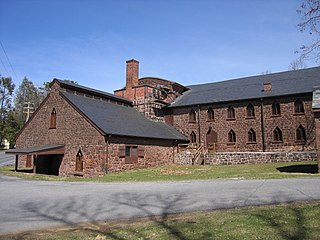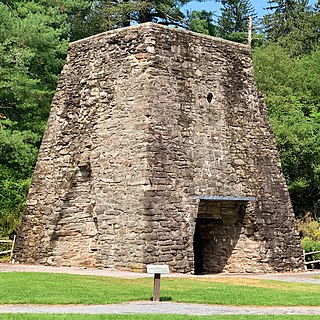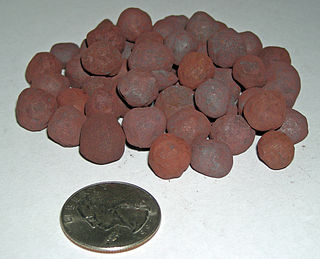Notes and references
Related Research Articles

A blast furnace is a type of metallurgical furnace used for smelting to produce industrial metals, generally pig iron, but also others such as lead or copper. Blast refers to the combustion air being supplied above atmospheric pressure.

The New Jersey Pine Barrens, also known as the Pinelands or simply the Pines, is the largest remaining example of the Atlantic coastal pine barrens ecosystem, stretching across more than seven counties of New Jersey. Two other large, contiguous examples of this ecosystem remain in the northeastern United States: the Long Island Central Pine Barrens and the Massachusetts Coastal Pine Barrens. The name pine barrens refers to the area's sandy, acidic, nutrient-poor soil. Although European settlers could not cultivate their familiar crops there, the unique ecology of the Pine Barrens supports a diverse spectrum of plant life, including orchids and carnivorous plants. The area is also notable for its populations of rare pygmy pitch pines and other plant species that depend on the frequent fires of the Pine Barrens to reproduce. The sand that composes much of the area's soil is referred to by the locals as sugar sand.

Wharton State Forest is the largest state forest in the U.S. state of New Jersey. It is the largest single tract of land in the state park system of New Jersey, encompassing approximately 122,880 acres (497.3 km2) of the Pinelands northeast of Hammonton. Its protected acreage is divided between Burlington, Camden, and Atlantic counties. The entire forest is located within the Atlantic coastal pine barrens ecoregion as well as the New Jersey Pinelands National Reserve. The forest is located in the forested watershed of the Mullica River, which drains the central Pinelands region into the Great Bay. The forest is under the jurisdiction of the New Jersey Division of Parks and Forestry.

A bloomery is a type of metallurgical furnace once used widely for smelting iron from its oxides. The bloomery was the earliest form of smelter capable of smelting iron. Bloomeries produce a porous mass of iron and slag called a bloom. The mix of slag and iron in the bloom, termed sponge iron, is usually consolidated and further forged into wrought iron. Blast furnaces, which produce pig iron, have largely superseded bloomeries.

Iron plantations were rural localities emergent in the late-18th century and predominant in the early-19th century that specialized in the production of pig iron and bar iron from crude iron ore.

Oxford Furnace is a historic blast furnace on Washington Avenue, near the intersection with Belvidere Avenue, in Oxford, Oxford Township, Warren County, New Jersey. The furnace was built by Jonathan Robeson in 1741 and produced its first pig iron in 1743. The first practical use in the United States of hot blast furnace technology took place here in 1834. The furnace was added to the National Register of Historic Places on July 6, 1977 for its significance in industry during the 19th century. It was later added as a contributing property to the Oxford Industrial Historic District on August 27, 1992.

Cornwall Iron Furnace is a designated National Historic Landmark that is administered by the Pennsylvania Historical and Museum Commission in Cornwall, Lebanon County, Pennsylvania in the United States. The furnace was a leading Pennsylvania iron producer from 1742 until it was shut down in 1883. The furnaces, support buildings and surrounding community have been preserved as a historical site and museum, providing a glimpse into Lebanon County's industrial past. The site is the only intact charcoal-burning iron blast furnace in its original plantation in the Western Hemisphere. Established by Peter Grubb in 1742, Cornwall Furnace was operated during the American Revolution by his sons Curtis and Peter Jr. who were major arms providers to George Washington. Robert Coleman acquired Cornwall Furnace after the Revolution and became Pennsylvania's first millionaire. Ownership of the furnace and its surroundings was transferred to the Commonwealth of Pennsylvania in 1932.

Howell Works was a bog iron-based production facility for pig iron which was established in New Jersey in the early 19th century by American engineer and philanthropist James P. Allaire. It is notable as one of the earliest American examples of a company town.

Atsion Lake is a man-made lake in Wharton State Forest in the Pine Barrens, in the community of Atsion, Burlington County, New Jersey. The lake is part of the Mullica River. It offers boating, hiking, fishing, swimming and camping facilities, and cross-country skiing in the winter.

Harrisville is an unincorporated community and ghost town located about 6 miles (9.7 km) northwest of New Gretna within Bass River Township in Burlington County, in the U.S. state of New Jersey, in the New Jersey Pine Barrens.

The Oregon Iron Company was an iron smelting company located in what is now Lake Oswego, Oregon. The company was established in 1865, and in 1867, became the first company west of the Rocky Mountains in the United States to smelt iron. The company failed after a few years, but was reorganized as the Oswego Iron Company in 1878, and again as the Oregon Iron and Steel Company in 1883. With the addition of a larger furnace, the last incarnation of the company prospered, reaching peak production in 1890. By 1894, however, pressure from cheaper imported iron combined with the effects of the Panic of 1893 forced the company to close its smelter. The company continued to operate a pipe foundry until 1928, and until the early 1960s, existed as a land management company, selling its real estate holdings which expanded the city of Lake Oswego.

Old Furnace State Park is a public recreation area adjacent to Ross Pond State Park in the town of Killingly, Connecticut. The state parks covers 367 acres (149 ha), sits at an elevation of 390 feet (120 m), and is open year-round for hiking, hunting, and fishing. It is located east of Interstate 395, south of U.S. Route 6 and north of Connecticut Route 695. The park is the site of a former iron furnace. It was established as a town park in 1909 before being transferred to the state in 1918.

Batsto Village is a historic unincorporated community located on CR 542 within Washington Township in Burlington County, New Jersey, United States. It is located in Wharton State Forest in the south central Pine Barrens, and a part of the Pinelands National Reserve. It is listed on the New Jersey and National Register of Historic Places, and is administered by the New Jersey Department of Environmental Protection's Division of Parks & Forestry. The name is derived from the Swedish bastu, bathing place ; the first bathers were probably the Lenni Lenape Native Americans.

Isabella Furnace was a cold blast charcoal iron furnace located in West Nantmeal Township, Pennsylvania. The furnace was named for Isabella Potts, wife of one of the partners, a member of the Potts ironmaking family. Isabella was the last iron furnace to be built in the county, in 1835, and was operated by members of the Potts family and their partners until 1855, when they lost control of it in a bankruptcy. It returned to the family in 1881, when it was purchased by Col. Joseph Potts, who modernized it. The furnace, the last to operate in Chester County, went out of blast in 1894, a few months after Col. Potts' death, but remained largely intact until after his son's death in 1943. The remains of the furnace complex have been listed in the National Register of Historic Places since 1991.

The Pine Grove Iron Works was a smelting facility in southcentral Pennsylvania during the Industrial Revolution. The works is notable for remaining structures that are historical visitor attractions of Pine Grove Furnace State Park, including the furnace stack of the Pine Grove Furnace. The site was listed on the National Register of Historic Places on April 13, 1977 for its significance in architecture and industry. It includes seven contributing buildings, two structures, fourteen sites, and two objects.
High Crossing is a ghost town in Tabernacle Township, in Burlington County, in the U.S. state of New Jersey.

Iron mining in the United States produced 48 million metric tons of iron ore in 2019. Iron ore was the third-highest-value metal mined in the United States, after gold and copper. Iron ore was mined from nine active mines and three reclamation operations in Michigan, Minnesota, and Utah. Most of the iron ore was mined in northern Minnesota's Mesabi Range. Net exports were 3.9 million tons. US iron ore made up 2.5 percent of the total mined worldwide in 2015. Employment as of 2014 was 5,750 in iron mines and iron ore treatment plants.

The US iron and steel industry has paralleled the industry in other countries in technological developments. In the 1800s, the US switched from charcoal to coal in ore smelting, adopted the Bessemer process, and saw the rise of very large integrated steel mills. In the 20th century, the US industry successively adopted the open hearth furnace, then the basic oxygen steelmaking process. Since the American industry peaked in the 1940s and 1950s, the US industry has shifted to small mini-mills and specialty mills, using iron and steel scrap as feedstock, rather than iron ore.

Thomas Rutter was an American ironmaster and abolitionist who constructed the first blast furnace and the first iron forge in the Province of Pennsylvania. Now known as Pine Forge Mansion and Industrial Site, the location of Rutter's mansion and iron plantation was listed on the National Register of Historic Places in 2004. The site has been the campus of Pine Forge Academy since 1945.

Samuel Richards was an American businessman and ironmaster. He was heavily involved in the New Jersey iron industry during the early 19th century, starting with his family's iron business in Batsto Village, New Jersey, where he apprenticed under his father, William Richards. Richards would eventually come into ownership of Weymouth Furnace and Martha Furnace in 1808, in addition to the Atsion Iron Works in 1822. His half brother, Benjamin Wood Richards, became mayor of Philadelphia.
References
- 1 2 3 Pierce 1957, p. 84.
- ↑ Pierce 1957, p. 71.
- 1 2 3 4 Pierce 1957, p. 85.
- ↑ Gordon 2001, p. 27.
- ↑ Gordon 2001, p. 59.
- ↑ Gordon 2001, p. 40.
- 1 2 3 4 5 Pierce 1957, p. 88.
- ↑ Pierce 1957, p. 86.
- 1 2 Pierce 1957, p. 87.
- 1 2 Pierce 1957, p. 89.
- ↑ Pierce 1957, pp. 88–90.
- ↑ Pierce 1957, p. 91.
- ↑ Pierce 1957, p. 90.
- 1 2 3 Pierce 1957, p. 92.
- ↑ Pierce 1957, pp. 92–93.
- ↑ Pierce 1957, p. 93.
- ↑ Coritz 1995, p. 1.
- ↑ Coritz 1995, p. 15.
- ↑ Coritz 1995, p. 13.
Works cited
- Coritz, Cynthia L. (June 19, 1995). Oswego River Natural Area Management Plan (PDF) (Report).
- Gordon, Robert B. (2001). American Iron 1607–1900. Baltimore, Maryland: Johns Hopkins University Press. ISBN 0-8018-6816-5.
- Pierce, Arthur D. (1957). Iron in the Pines. New Brunswick, New Jersey: Rutgers University Press. ISBN 0-8135-0514-3.